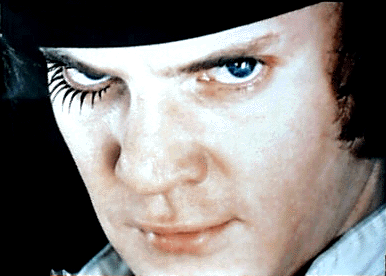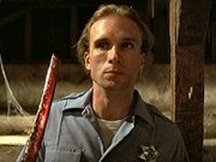Queezy Subjects: Exploring the Darker Side of Film (September 2006)
Hi Kiddies...
This was going to remain merely a little Aftertaste segment at the end of Lone Wolf and Cub: Baby Cart to Hades, but as I typed, I realized that this topic is one I haven't heard broached too often, and one worthy of exploration.
 Let me give all the film viewers and makers out there the lowdown on a touchy little subject in film: The Rape Scene.
Let me give all the film viewers and makers out there the lowdown on a touchy little subject in film: The Rape Scene.Everyone in the world knows that rape is an atrocious crime, and due to its impact, including such a scene in a film must serve an equally heavy purpose. Typically, in film it's used in one of three ways:
Rape as "The Ordinary World": When a story begins with rape, it sets the tone of the universe around us most effectively. Such a shocking event drives home quickly and perfectly the state of things. A land where lawlessness and criminal acts of this calibre exist is a bad, immoral place, and/or the people committing those acts are without a doubt the ones in the wrong. Plots tend to lean towards themes of justice, chivalry, and vengeance, that sort of thing. We also are left without any mystery as to the dark nature of those committing the act.

Our second use, as introduced by our lovely little "Duelin' Banjos" player above, Rape as Plot: In short, when a story is ABOUT a rape, where a tale shifts from what it was or could have been to the profound effect this act leaves on its characters. Deliverance (1972) is certainly one of the best-known examples. Here we also tends to focus on themes of vengeance, but may include a vast array of character studies and off-shooting plotlines. Other disturbing examples of this are The Accused (1988), the little known cult classic I Spit On Your Grave (1978), and possibly the most disturbing of all, Irreversible (2002). It doesn't pull any punches. It's graphic, sinister and the vengeance is just as stomach-turning. It shows us that the course these characters take is nowhere near the side of heroic justice, it's sick, it's unforgivable, just like the initial rape.
 Then we have our last example, Rape as Character Development. This use includes the act not as integral plot, not as statement of macrocosmic truth, but rather as a catalyst for change on a more minor scale. Perhaps the character can cope better than others, or it's just part of the occupational hazard of being in a particular situation, but it is an event that brings us to realize that minor changes are to take place due to this heavy event. For example we have Elizabeth Shue's gang rape by frat boys in Leaving Las Vegas (1995) that serves as a reminder of the danger she faces as a prostitute, and enhances to the audience the type of person she must be, or needs to become to change or cope. In American History X (1998), we have prison rape used on Ed Norton as punishment for insubordination. This reveals to him all too much about the nature of those he once associated with, and begins his maturity towards open-mindedness and acceptance. Pulp Fiction (1994) is another fantastic example, as it uses this act not only to cause the audience to just sit there with mouths agape at the odd non sequitur, but it creates opportunity for deeper characterization, as we grow to understand the moralities of our two victims like no other thing could show us.
Then we have our last example, Rape as Character Development. This use includes the act not as integral plot, not as statement of macrocosmic truth, but rather as a catalyst for change on a more minor scale. Perhaps the character can cope better than others, or it's just part of the occupational hazard of being in a particular situation, but it is an event that brings us to realize that minor changes are to take place due to this heavy event. For example we have Elizabeth Shue's gang rape by frat boys in Leaving Las Vegas (1995) that serves as a reminder of the danger she faces as a prostitute, and enhances to the audience the type of person she must be, or needs to become to change or cope. In American History X (1998), we have prison rape used on Ed Norton as punishment for insubordination. This reveals to him all too much about the nature of those he once associated with, and begins his maturity towards open-mindedness and acceptance. Pulp Fiction (1994) is another fantastic example, as it uses this act not only to cause the audience to just sit there with mouths agape at the odd non sequitur, but it creates opportunity for deeper characterization, as we grow to understand the moralities of our two victims like no other thing could show us.
Now here's the lesson: Rape is not something people want when they consider going out to see a movie that's going to be 'a good time', so there must be common rules of decency to be used when considering using this scene in a film.
In the event that a film should use Rape as "The Ordinary World", be aware that this is merely a symbolic representation of the world's ills, and does not do anything to advance the plot. The point is made clear in seconds, rather than minutes, so when not integral, spare us the details, it doesn't turn us on, and you risk turning a good time into an awkward moment.
 The opposite is true with Rape as Plot. If you ask me, draw it out. If this is a horrible event that our characters can't deal with, something that is so traumatic that they go out of their way to commit acts of vengeance upon the aggressors, or devote the next few months or years to seeking justice. Why should we not also feel the full effect, connecting tragically with our protagonist? You probably know going in that this is not some popcorn-Smores-slumber-party night movie, so hit us hard. I say if you're making this theme into a movie, make it right, zoom in up close and make us feel truly uncomfortable.
The opposite is true with Rape as Plot. If you ask me, draw it out. If this is a horrible event that our characters can't deal with, something that is so traumatic that they go out of their way to commit acts of vengeance upon the aggressors, or devote the next few months or years to seeking justice. Why should we not also feel the full effect, connecting tragically with our protagonist? You probably know going in that this is not some popcorn-Smores-slumber-party night movie, so hit us hard. I say if you're making this theme into a movie, make it right, zoom in up close and make us feel truly uncomfortable.
Rape as Character Development is about the moment, it should never be as graphic or long-lasting as Rape as Plot, but should drive the point home just enough. In the films I've seen, often the next scene hits home harder and reminds us better than the act itself: Ed Norton sitting down uncomfortably, Elizabeth Shue bleeding out in the shower.
Film is a medium where the most tragic tales can be told, where we can explore the darkest side of human nature, but this is a medium for an audience, and keeping that audience ever in mind, including such a scene should be pored over and reconsidered several times before leaving it as part of the final edit.
Finally, more than anything else, don't use it to arouse us. Doing so is a terrible disservice unto society as a whole. No matter how cool Pulp Fiction may be, Rape is not, even if you use Sexploitation as an excuse.
Thanks for reading kiddies...




<< Home